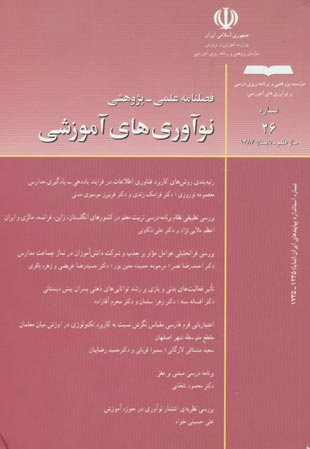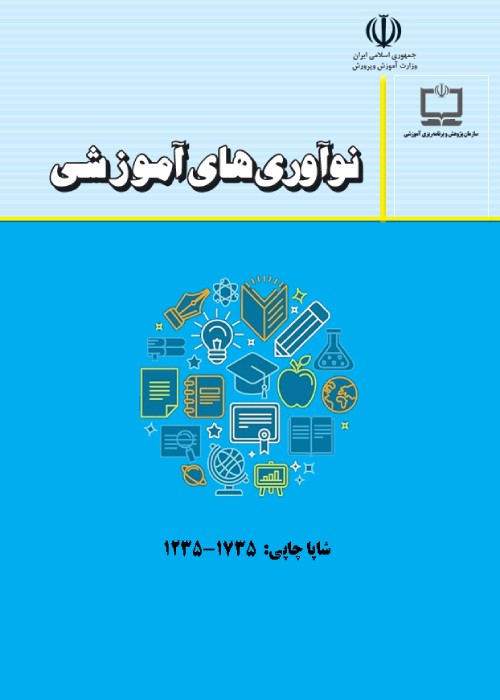فهرست مطالب

فصلنامه نوآوری های آموزشی
پیاپی 26 (تابستان 1387)
- 192 صفحه، بهای روی جلد: 10,000ريال
- تاریخ انتشار: 1387/05/29
- تعداد عناوین: 9
-
-
صفحه 7
-
صفحه 127
-
Page 9Nowadays, information and communication technology (ICT) plays a fundamental role in many fields. Education is one of the fields that has been reformed by information technology. In this research, the application of information technology in teaching-learning process, has been investigated in educational system. Using the experiences of different countries in applying information technology in teaching-learning process, twenty three different methods of ICT applications were extracted. Then, using the viewpoints of information technology experts in the education system, these methods were evaluated based on ten different indexes, for three educational stages of general, theoretical and technical high school. Finally, using TOPSIS decision making techniques, the obtained data have been analyzed and the best innovative methods for different educational stages have been presented and explained.
-
Page 35Using a comparative study, the curriculum of teacher training system in England, Japan, France, Malaysia were compared with Iran. To offer some applied suggestions in order to improve the Iran’s curriculum of teacher training system, the similarities and differences in the elements of teacher training curriculum among the mentioned countries is investigated. Bredy’s study method was used in this study. The most important findings are as follows:In the teacher training system of the above mentioned countries, the main goal was the improvement of the quality of the system and the main objective was life long learning. In order to achieve these goals and objectives, the following strategies was considered: Integration of theory and practice, balance between theory and practice in the curriculum, setting teacher training standards, integration of ICT in the teacher training curriculum, making continuous connection between the pre-service teacher training with universities and schools, making connection between pre and in-service teacher training, and coordination among administrating organizations of teacher training in these countries.
-
Page 63Due to the individual, social and cultural advantages of praying, the schools tried to internalize it in their program and have done some researches about it. The aim of this study was to consider the influential factors on attracting the students to participate in schools’ public praying. To do so, all of the related research projects which have been done throughout the country were gathered. Fifteen of them which contained the characteristics of meta analysis assessment, particularly the assessment of effect size, were considered. For meta analysis, the Hedges approach and for interpretation of findings, the Cohen approach were used. The findings were categorized in twenty six items and seven categories. The seven categories include: personal, family, and within school human factors, within school physical factors, other school factors, peers and environment.
-
The impact of physical activities and plays on the development of mental abilities of preschool boysPage 87In this research, the impact of physical activities and play on the development of mental abilities of preschools’ boys was investigated. The participants were 60 Iranian preschool and nursery children selected during the 2005-2006 school year, from the second education district of Tehran preschool and nurseries. They were divided up into experimental (N=30) and control (N=30) groups and their age distribution was 4:3-4:9 and 5:3- 5:9 years old. Firstly, a pre-test was administered for both experimentaland control groups. After two months of introducing treatments (organized physical activities and plays) to the experimental group, a post-test was administered among both experimental and control groups. In order to see if physical activities and plays could influence the development of mental abilities of preschool’ boys (space perception and body image), three tests, including “draw a man test”, cumulative copied drawings, and cumulative by heart drawings were used. The findings show that the treatments haveincreased significantly the mental abilities of the experimental group. So, implicitly, we could say that the physical activities and plays can facilitate the development of mental abilities of preschool children.
-
Page 107The main purpose of this paper was to present a technology attitude scale for education. So, 311 Isfahani high school teachers were selected from among Isfahani high school teachers, using multistage cluster sampling. The instrument used was the Persian translation of Turkish Technology Attitude Scale. After gathering the data, they were analyzed using SPSS software. After deleting items with lower correlation, the Alpha reliability coefficient for the scale was 0.84. The factor analysis of the items of the scale showed that more than 61% of the variance of the whole scores could be explained using this scale. After Varimax rotation of the factors, the correlation between each item with each factor was determined and five factors were named according to that. Also, it showed that the scale ismulti-dimentional. The results of the independent T-test indicated that there is no significant difference between male and female teachers’ attitudes toward technology, however, the technical school teachers had better attitudes in proportion to their high school colleagues. In sum, the teachers’ attitude was positive. This scale could be used in other researches as an exact device.
-
Page 127Curriculum is a set of opportunities for learning, however, the meaning of learning is changing. Thus, our concept of learning will affect the opportunities we provide for the students. Findings from brain researches has influenced the concept of learning. In this view, brain is a unique entity that is fragmented in educational system and the differences among them are ignored. So, our knowledge about the brain could have an impact on our knowledge about the curriculum. For instance, knowing that learning is aprocess for rewiring the neural network, results in the question that whether curriculum provides such an opportunity for learners. Therefore, in this paper, we try to reveal the influence of findings from brain researches on the elements of curriculum.Findings show that the curriculum objectives should be connected to the real life of students. Addressing the whole brain is very important in such a curriculum, and the role of art and music are emphasized. Evaluation focuses on the learning process and students’ self-evaluation is taken into consideration. Since brain is a unique network and the children’ developmental process is different; it is not possible to fit the curriculum just with the chronological age of students. This kind of curriculum intends to enrich the learning environment and emphasizes the emotional space. Also, such a curriculum supports the schools’ social life and considers the students’diversity in learning styles and preferences.
-
Page 151The aim of this paper is to investigte the diffusion of innovation theory in the field of education. To do this, we considered the comprehensive definition of diffusion of innovation theory by focusing on its four essential elements (innovation, communication channels, time, social system). Then, the necessary requirements for spreading innovations (relative advantage, relative compatibility, ease of use, testability, observability), and the people who involved in this matter (innovators, early adopters, early majority, late majority, sceptics) were examined. Then, the impact of innovations on the most important factors of education system (schools, human elements particularly teachers, educational materials and teachinglearning methods) has been addressed. Finally, some suggestions for encouraging and accepting educational innovations have been offered.


